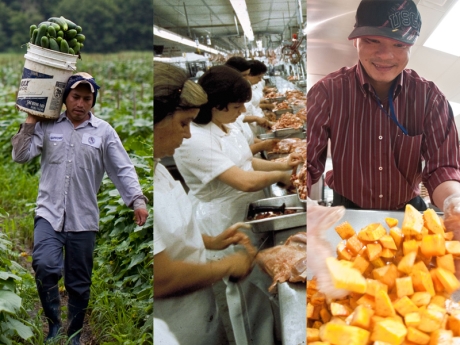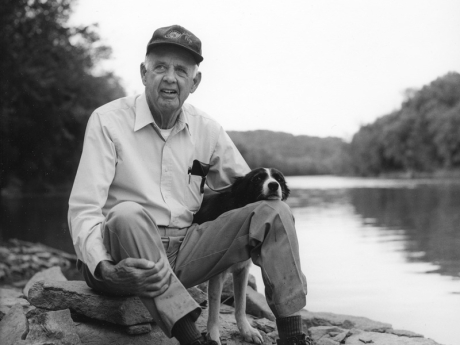The Food System
Food’s Journey

Our food may pass through the hands of farm workers (left), processing plant workers (middle), food safety inspectors, truck drivers, warehouse managers, grocery store owners, kitchen staff (right), and many others involved in food supply chains.
Photo credits (L-R): Laura Elizabeth Pohl/Bread for the World, Creative Commons CC BY-NC 2.0; Joe Valbuena, USDA; USDA, Creative Commons CC BY 2.0.
Our food may pass through the hands of farm workers (left), processing plant workers (middle), food safety inspectors, truck drivers, warehouse managers, grocery store owners, kitchen staff (right), and many others involved in food supply chains.
On Sunday afternoon, Ashley sits down to a snack in her Des Moines, Iowa, apartment: an eight-ounce container of strawberry yogurt. What steps were involved in getting Ashley’s yogurt to her refrigerator?
The milk used in the yogurt (93 percent of its weight) is from one of Iowa’s larger dairy operations, where over 500 cows are milked several times daily by robotic systems.1,2 The strawberries were grown in Florida and California, and harvested by seasonal farm workers from Mexico and Central America. The yogurt was sweetened with sugar from beets grown in North Dakota. All of these ingredients were then shipped by truck and rail to a processing plant in Iowa where active yogurt cultures were added and the final product was sealed in plastic cups. Cases of the yogurt were delivered to a distribution warehouse near Des Moines, then to a supermarket near Ashley’s apartment.
Food takes a complex journey from farms, ranches, and waterways to our plates. The journey begins with natural capital, such as soil, freshwater, and the countless organisms that contribute to our food supply. Along the way, it may pass through the hands of food safety inspectors, warehouse managers, grocery store owners, and many others involved in food supply chains. The route to our plates is further influenced by the decisions of businesses, scientists, policymakers, and consumers. The people, activities, inputs, outputs, and outcomes involved in getting Ashley’s meals onto her plate are all part of the food system.
While Ashley is fictional, her yogurt’s journey is based on actual scenarios.3
Food and the Environment
"How we eat determines, to a considerable extent, how the world is used."
– Wendell Berry28

The U.S. food system supplies an abundance of food—an estimated 2,590 calories per citizen per day in 2010, after subtracting wasted food.7 It also generates health and environmental hazards, such as packaging waste (middle) and pollution from industrial egg (left) and swine (right) operations.
Photo credits (L-R): CLF; lyzadanger, Creative Commons CC BY-SA 2.0; Jeff Vanuga, USDA Natural Resources Conservation Service, public domain.
The U.S. food system supplies an abundance of food—an estimated 2,590 calories per citizen per day in 2010, after subtracting wasted food.7 It also generates health and environmental hazards, such as packaging waste (middle) and pollution from industrial egg (left) and swine (right) operations.
Photo credits (L-R): CLF; lyzadanger, Creative Commons CC BY-SA 2.0; Jeff Vanuga, USDA Natural Resources Conservation Service, public domain.
James is concerned about the environment, and believes human activity is responsible for the current period of rapid climate change. James’ view on climate change is consistent with the overwhelming body of scientific evidence,4 even though it is shared by less than half of his fellow U.S. citizens.5 He follows a whole-food, plant-based diet for most days of the week, and frequently shops at a farmers’ market so he can support farmers who follow agroecological principles. He values supporting his local economy, but also recognizes that what he eats, and how it is produced, is more important for the environment than how far his food travels.6 He is careful not to purchase more than he can eat, and when food waste is unavoidable, he composts it rather than letting it go to a landfill.
James is fictional, but following his example could produce real benefits. Our food choices (along with policy, technology, culture, and other influences) drive agricultural practices that affect air, water, soil, biodiversity, and other threatened natural resources. More than just environmental concerns, these are concerns for public health, not least because human civilizations and the long-term viability of our food supply depend on natural capital and a stable climate.
Food and Health
"People are fed by the food industry, which pays no attention to health, and are healed by the health industry, which pays no attention to food."
– Wendell Berry8

Studies suggest people mimic the eating behaviors of their friends, families, and co-workers.9 In households where parents regularly eat fruits and vegetables, for example, children are more likely to do the same.10–12
Image copyright.
Food can promote good health, protect against disease, and incite feelings of joy and satisfaction (left). The food system is an important part of the economy; at least one in six members of the U.S. work force are employed in the food chain (middle).15 Growing, processing, cooking, and sharing food can also be expressions of culture (right).
Photo credit: Thinkstock, copyright.
Brian lives in Southwest Baltimore. He earns a little over minimum wage working as a custodian. He has nerve damage in his foot, a complication of type 2 diabetes, making walking difficult. Like many residents in his neighborhood, he doesn’t own a vehicle, and the nearest supermarket is over a half mile away.9 Public transit is unreliable, so he usually shops for food at the closest corner store, which doesn’t carry any fresh produce or whole wheat bread.10 When he is able to carpool to the supermarket, Brian uses his monthly SNAP benefits (food stamps) to stock up on canned goods, soda, and other non-perishable, low-cost items.
Brian’s cousin, D’Anne, lives with her family in North Carolina and faces a different kind of struggle. Four years ago, a 14,000-head swine operation—typical in size for large hog farms in the state1—was built within a mile of their home. The odors from the operation are so strong that she has to keep the windows closed.11
Sharon, a fifth-generation hog farmer, runs the operation near D’Anne’s home. Sharon is regularly exposed to hydrogen sulfide, animal dander, and other airborne contaminants. She often experiences wheezing and chest tightness.12 In her occupation, one in four workers have some form of respiratory illness.13 Several years ago, Sharon suffered a cut on her leg that became infected with an antibiotic-resistant strain of streptococcus bacteria. The infection was nearly fatal, requiring multiple doses of different drugs to treat.14
Brian, D’Anne, and Sharon are fictional, but their experiences are based on actual events and evidence. These scenarios illustrate problems of food insecurity, the impact of industrial livestock operations on communities, and occupational hazards—a few of the many public health challenges in the food system.
Why Study the Food System?

Farmer, author, and poet Wendell Berry alluded to the relationships among diet, food production, public health, and the environment when he wrote, “Eating… is inescapably an agricultural act, and how we eat determines, to a considerable extent, how the world is used.”28
Photo credit: Guy Mendes. All rights reserved.
Farmer, author, and poet Wendell Berry alluded to the relationships among diet, food production, public health, and the environment when he wrote, “Eating… is inescapably an agricultural act, and how we eat determines, to a considerable extent, how the world is used.”28
Photo credit: Guy Mendes. All rights reserved.
Learning about the food system often begins with personal interests, such as wanting to know where our food comes from, whether what we are eating is safe or healthy, or how to preserve a batch of tomatoes. But the food system also has ties to widespread global challenges, such as climate change, chronic illness, infectious disease, social inequality, animal welfare harms, environmental degradation, and the concentration of economic power.
Addressing these challenges requires system thinking – recognizing, for example, how changing one part of the system affects the others. The heavy use of certain pesticides was born of a desire to control pests, but has led to problems of pesticide-resistance16,17 and harmful effects on humans and wildlife.18–27 Understanding the complex, dynamic relationships among food, health, society, and ecosystems is critical to avoiding these kinds of problems.
Learning about these connections can empower people to become “food citizens” who make informed food choices (“voting with their forks”), advocate for policy, and even grow and process some of their own food. Some may additionally pursue careers in agriculture, nutrition, public health, ecology, public policy, education, and other fields that offer powerful opportunities for food system change. Fostering a healthy, just, and sustainable food system requires people with expertise across many disciplines.
Resources
This list is a starting point for further exploration. Some materials may not reflect the views of the Johns Hopkins Center for a Livable Future.
For teachers
- Exploring Our Food System (lesson plan). FoodSpan. Johns Hopkins Center for a Livable Future.
- Introduction to the US Food System: Public Health, Environment, and Equity (textbook). Neff RN (editor). Johns Hopkins Center for a Livable Future. 2014.
Reports and websites
- Toward a Healthy Sustainable Food System. Neff RN. American Public Health Association. 2007.
- Food System Map (website). Nourish.
Academic journal articles
- A Food Systems Approach To Healthy Food And Agriculture Policy (requires subscription). Neff RN, Merrigan K, Wallinga D. Health Affairs. 2015.
- Food System Policy, Public Health, and Human Rights in the United States (requires subscription). Shannon KL, Kim BF, McKenzie S, Lawrence RS. Annual Review of Public Health. 2015.
- Food Systems and Public Health: Linkages to Achieve Healthier Diets and Healthier Communities (open access). Journal of Hunger & Environmental Nutrition. 2009.
- Conceptualizing food systems for global environmental change research (open access). Ericksen PJ. Global Environmental Change. 2008.
- A conceptual model of the food and nutrition system (requires subscription). Sobal J, Khan LK, Bisognia C. Social Science & Medicine. 1998
References
- USDA. 2012 U.S. Census of Agriculture. 2014.
- Iowa State University Extension and Outreach. Iowa Dairy Farm Survey. 2012.
- Pirog R, Benjamin A. Calculating Food Miles for a Multiple Ingredient Food Product. Ames, Iowa: Leopold Center for Sustainable Agriculture; 2005.
- IPCC. Summary for policymakers. In: Field CB, Barros VR, Dokken DJ, et al., eds. Climate Change 2014: Impacts, Adaptation, and Vulnerability. Part A: Global and Sectoral Aspects. Contribution of Working Group II to the Fifth Assessment Report of the Intergovernmental Panel on Climate Change. Cambridge, United Kingdom and New York, NY, USA: Cambridge University Press; 2014.
- Pew Research Center. Climate Change: Key Data Points from Pew Research. 2014.
- Weber CL, Matthews HS. Food-miles and the relative climate impacts of food choices in the United States. Environ Sci Technol. 2008;42(10):3508-3513.
- USDA Economic Research Service. Loss-Adjusted Food Availability. 2014.
- Berry W. Sex, Economy, Freedom & Community: Eight Essays. New York: Pantheon Books; 1993.
- Johns Hopkins Center for a Livable Future. Maryland Food System Map. 2014.
- Franco M, Diez Roux A V, Glass T a, Caballero B, Brancati FL. Neighborhood characteristics and availability of healthy foods in Baltimore. Am J Prev Med. 2008;35(6):561-567.
- Environmental Defense Fund. Hogwatch Testimonials. 1998.
- Dosman JA, Lawson JA, Kirychuk SP, Cormier Y, Biem J, Koehncke N. Occupational asthma in newly employed workers in intensive swine confinement facilities. Eur Respir J. 2004;24(4):698-702.
- Donham KJ, Wing S, Osterberg D, et al. Community health and socioeconomic issues surrounding concentrated animal feeding operations. Environ Health Perspect. 2007;115(2):317-320.
- Kremer R. From Superbugs to Sustainability: a Fifth-Generation Producer’s Mission to Raise Pigs without Antibiotics. Huffingt Post. April 2013.
- Food Chain Workers Alliance. The Hands That Feed Us: Challenges and Opportunities for Workers along the Food Chain. 2012.
- Van Den Bosch R. Public health advantages of biological insect controls. Environ Health Perspect. 1976;14:161-163.
- Kirschenmann FL. Cultivating an Ecological Conscience: Essays from a Farmer Philosopher. Lexington, KY: The University Press of Kentucky; 2010.
- Hayes TB, Khoury V, Narayan A, et al. Atrazine induces complete feminization and chemical castration in male African clawed frogs (Xenopus laevis). Proc Natl Acad Sci U S A. 2010;107(10):4612-7.
- Horrigan L, Walker P, Lawrence RS. How sustainable agriculture can address the environmental and public health harms of industrial agriculture. Environ Health Perspect. 2002;110(5).
- Devine GJ, Furlong MJ. Insecticide use: contexts and ecological consequences. Agric Human Values. 2007;24:281-306.
- Brittain C, Potts SG. The potential impacts of insecticides on the life-history traits of bees and the consequences for pollination. Basic Appl Ecol. 2011;12(4):321-331.
- Henry M, Béguin M, Requier F, et al. A Common Pesticide Decreases Foraging Success and Survival in Honey Bees. Science. 2012;336(6079):348-350
- Whitehorn PR, O’Connor S, Wackers FL, Goulson D. Neonicotinoid Pesticide Reduces Bumble Bee Colony Growth and Queen Production. Science. 2012;336(6079):351-352.
- Chensheng LU, Archol KMW, Allahan RAC. Sub-lethal exposure to neonicotinoids impaired honey bees winterization before proceeding to colony collapse disorder. Bull Insectology. 2014;67(1):125-130.
- VanEngelsdorp D, Evans JD, Saegerman C, Mullin C, Haubruge E. Colony Collapse Disorder: A Descriptive Study. PLoS One. 2009;4(8).
- Spivak M, Mader E, Vaughan M, Euliss NH. The Plight of the Bees. Environ Sci Technol. 2011;45:34-38.
- beeinformed.org. 2014.
- Berry W. The Pleasures of Eating. In: What Are People For? New York: North Point Press; 1990.
